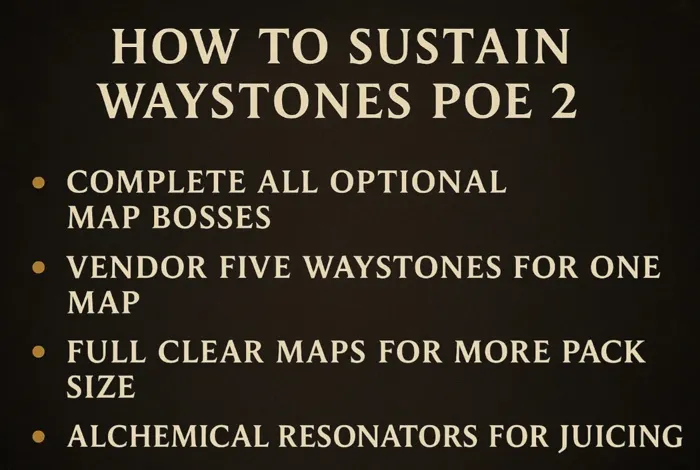Cart Empty
Continue ShoppingIn Path of Exile 2, sustaining Waystones is essential for long-term map farming efficiency. These powerful keystones allow players to continuously run high-tier content without constantly resetting progression or relying on RNG for map returns. If you're looking to streamline your endgame grind and maintain control over your map pool, this guide will help you understand the mechanics behind Waystones and how to keep them going consistently.

Waystones in PoE 2 are essentially modifiers that let you customize and sustain specific mapping experiences. They're like portable enhancements that interact with your Atlas progression. Whether you're targeting specific boss encounters or just want reliable access to lucrative layouts, Waystones are your key tool.
But here's the catch: they're not infinite. If you don't actively sustain them, you'll run dry fast. So, sustainability becomes the real endgame.
Some map modifiers directly increase the chance of a Waystone drop or refresh. These include:
Maps with high monster density naturally give you more chances to drop new Waystones or refresh existing ones. The more monsters you kill, the more chances you have to restock.
League content like Delirium, Breach, Legion, and Abyss often flood your screen with enemies—and more enemies means more drop potential. Integrating these mechanics into your map runs significantly boosts your Waystone drop rate.
Use Scarabs or Atlas passives to force these mechanics into your maps regularly. Waystones drop as part of the global loot pool, so the more you interact with dense mechanics, the better your odds.
Atlas passives are one of the most powerful tools for sustaining Waystones in PoE 2. Focus on nodes that:
Some regions may also have specific passive bonuses that directly affect Waystone-related mechanics or item drops, so plan your tree accordingly.
While farming Waystones is ideal, don't forget you can always buy or trade for them. If you're low on Waystones but heavy on currency or duplicate maps, consider engaging with other players through the in-game trade board or community trade sites.
This is especially useful when you need a specific Waystone for a certain farming strategy and don't want to rely on RNG.
Don't waste valuable Waystones on Tier 1-5 maps or low-yield layouts. Save them for content that provides good returns—whether it's experience, currency, or boss fragments. Being strategic about where and when to use Waystones helps ensure you're not constantly running short.
Sextants and Compasses can be used to force high-mob-density effects or even increase your chances of finding specific league encounters. When paired with Waystones, these mods drastically improve both loot and sustainability.
Combo example: Map → Sextant → Scarabs → League mechanic → Waystone = max value.
It's easy to forget what you have when you're running dozens of maps in a session. Keep your stash organized and track your Waystones manually or with a loot management tool. Knowing when you're low can help you switch to more sustainable maps in advance.
Waystones are more than just a QoL feature—they're the backbone of long-term endgame mapping in PoE 2. By understanding how they work and applying the right strategies, you'll avoid dry streaks and keep your map pool healthy and profitable.
Whether you're a casual mapper or an Atlas completionist, sustaining Waystones is all about density, planning, and smart usage. Stick to high-yield mechanics, optimize your tree, and don't be afraid to trade if RNG doesn't go your way.